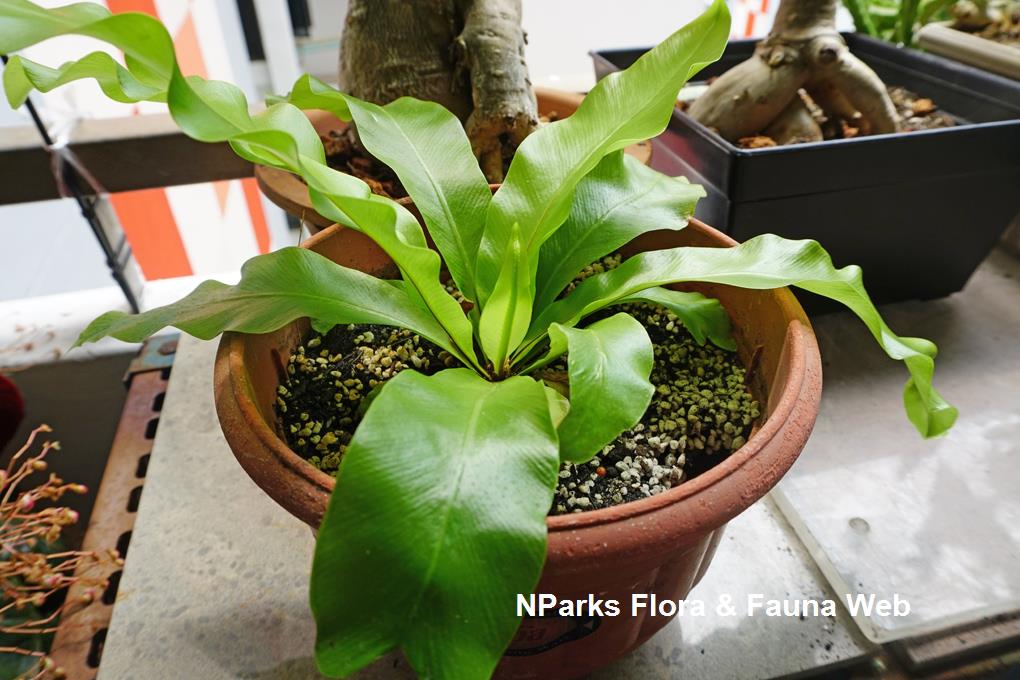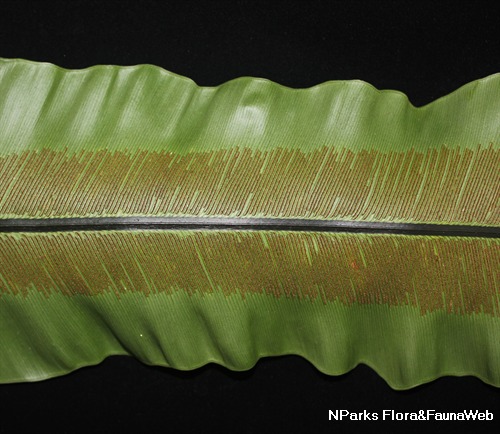.jpg)
Back
Asplenium nidus L. var. nidus
| Family Name: | Aspleniaceae |
| Synonyms: | Asplenium ellipticum (Fée) Copel., Asplenium ficifolium Goldm. |
| Common Name: | Bird's Nest Fern, Rumah Langsuyar, Paku Pandan, 巢蕨 |
Name
Classifications and Characteristics
| Plant Division | Ferns & Lycophytes (Non-Seed Vascular Plants) (Fern) |
|---|---|
| Plant Growth Form | Herbaceous Plant |
Biogeography
| Native Distribution | Tropical Africa, Tropical Asia, Pacific |
|---|---|
| Native Habitat | Terrestrial |
| Preferred Climate Zone | Tropical, Sub-Tropical / Monsoonal |
| Local Conservation Status | Native to Singapore (Least Concern (LC)) |
Description and Ethnobotany
| Growth Form | Epiphytic fern having a stout and erect rhizome, bearing a rosette of leaves at the top. |
|---|---|
| Roots | Large roots with many persistent brown root hairs. |
| Foliage | Leaf stalks are stout and almost black, can be as long as 5 cm, leaf length can be up to 150 cm or more and up to 20 cm wide. It narrows gradually, tapering both towards the pointed tip and towards the base. |
| Others - Plant Morphology | The sori are narrow, and occur on every vein of the top half of the frond. Spores are light brown, transparent when fresh and opaque when old. |
| Habitat | Occurs from sea level up to an altitude of about 1700 m. |
| Etymology | Genus Asplenium means without spleen and is usually a reference for the fern to cure spleen ailments. Species nidus gives reference to the common name "Bird's Nest Fern" as it means "Nest-of-fledglings". |
| Ethnobotanical Uses | Edible Plant Parts : Edible Leaves Medicinal: In Malaysia, the infusion of the leaves has been used to ease labor pains and the lotion obtain from the leaves has been used to treat fever. This information is not meant to be substituted for medical advice. Always consult a medical professional regarding any medical problems and before undertaking any major dietary changes. |
Landscaping Features
| Desirable Plant Features | Ornamental Foliage |
|---|---|
| Landscape Uses | Interiorscape/ Indoor Plant, Parks & Gardens, Small Gardens |
Fauna, Pollination and Dispersal
| Seed or Spore Dispersal | Abiotic |
|---|
Plant Care and Propagation
| Light Preference | Semi-Shade, Full Sun |
|---|---|
| Water Preference | Moderate Water |
| Plant Growth Rate | Slow |
| Rootzone Tolerance | Easy to Grow, Moist Soils |
| Propagation Method | Spore |
Foliar
| Foliage Retention | Evergreen |
|---|---|
| Mature Foliage Colour(s) | Green |
| Foliar Type | Simple / Unifoliate |
Image Repository
Others
| Master ID | 245 |
|---|---|
| Species ID | 1541 |
| Flora Disclaimer | The information in this website has been compiled from reliable sources, such as reference works on medicinal plants. It is not a substitute for medical advice or treatment and NParks does not purport to provide any medical advice. Readers should always consult his/her physician before using or consuming a plant for medicinal purposes. |

.jpg)













.jpg)